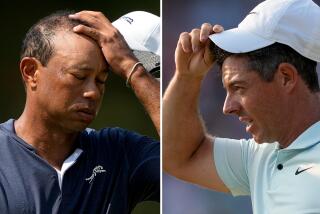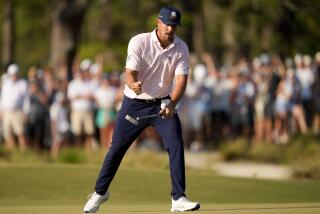PGA Championship, Last of the Majors, Begins Thursday at Denver’s Cherry Hills
DENVER — The fourth and final major professional golf competition of the year begins next Thursday on one of the special crossroads in the game’s history--the Cherry Hills Country Club.
It has been a year of change and oddity in the world of golf and it is therefore fitting that the closing major tournament of the season--the PGA Championship--takes place on a course known for the unusual and famous for its role in one of the sport’s most obvious turning points.
On a June afternoon in 1960 the game of golf rounded a corner and moved into an era which is only now beginning to drift into the history books.
The leading cast members on that day were Ben Hogan, Jack Nicklaus and Arnold Palmer although a host of supporting players jumped on and off the stage.
Hogan came close to winning a record fifth U.S. Open (never again to challenge for it) and Nicklaus came close to winning his first.
But it was Palmer who made the most history at Cherry Hills that afternoon, knocking his opening tee shot in the final round onto the green 346 yards away, firing a 65, making up seven shots on the leader and winning his one and only Open title.
This will be the fifth major championship at Cherry Hills and the second PGA. Lee Trevino will be defending the title he won at Shoal Creek and will be returning to a course on which he was a factor during the first two rounds of the 1978 Open.
Among other things the Cherry Hills layout has become known for large-scale comeback victories.
Vic Ghezzi was three holes down with nine to play in the 1941 PGA final (the tournament was conducted as a match play event in those days), but rallied to tie Byron Nelson after the regulation 36 and went on to win on the second extra hole.
Ralph Guldahl was 10 shots behind when the final round of the 1938 U.S. Open started, but he shot a 69 to win while third-round leader Dick Metz posted a 79.
Palmer not only trailed leader Mike Souchak by seven shots with one round to go in 1960, but he had to pass 14 other players as well.
Andy North broke the string of comeback victories at Cherry Hills in the 1978 Open, but after building a five-stroke lead in the final round he had to hang on and eventually won by just one shot over Dave Stockton and J.C. Snead.
Some history repeated itself this year when North, winless since his victory at Cherry Hills, took advantage of Tze-Chung Chen’s disasters and again captured the Open by a shot with a final-round 74.
History will once more be a subject for discussion during Open week. It may not repeat itself, but at least it has a chance to which was not the case when the Open was held here seven years ago.
Palmer’s tee shot to start the final round of the 1960 Open immediately elevated the opening hole at Cherry Hills into a special place in golfing lore.
The hole measured 346 yards the day Palmer ripped that tee shot onto the green, but when the U.S. Open returned to Cherry Hills in 1978 a new tee was added which extended the hole to 399 yards.
The day before the 1978 Open began, Frank D. “Sandy” Tatum (then president of the United States Golf Association) argued that the change was for the best.
“My personal feeling,” said Tatum at the time, “is that the first green should only have been hit once from the tee, by Arnold Palmer in 1960 (actually other players reached the green that week).
“It adds another bit of history and tradition to the U.S. Open and that’s exactly what we want.”
That opinion, however, was not universally held.
Before this year’s Open, David Graham held forth on the subject of such holes as the first at Cherry Hills.
“You take the excitement out of the hole when you do that,” Graham said. “Actually you make it an easier hole. When you make it longer, you automatically lay up and it makes a par fairly routine.
“But when the hole is short and you take the risk of going for the green you can easily wind up in trouble and make a double bogey or worse.”
PGA officials agreed with Graham and many others who were of like feelings. The first hole at Cherry Hills, therefore, will return to its traditional length of 346 yards for this year’s event.
As for potential winners, the possibilities are clearly varied since variety has been the keynote on the golf circuit in 1985.
The foreign contingent is strong, although British Open winner Sandy Lyle has declined an invitation. Lyle instead will play in the Glasgow Open. The overall strength of the foreigners has been demonstrated in the major championships this year, and the wave of young players has made a huge dent in the PGA tour’s bank account.
And a quarter of a century after his famous shot Palmer plans to be there as well. He may not reach the first green with a tee shot this year, but there will likely be a number of interested people standing around the first tee when he tries.
More to Read
Go beyond the scoreboard
Get the latest on L.A.'s teams in the daily Sports Report newsletter.
You may occasionally receive promotional content from the Los Angeles Times.










